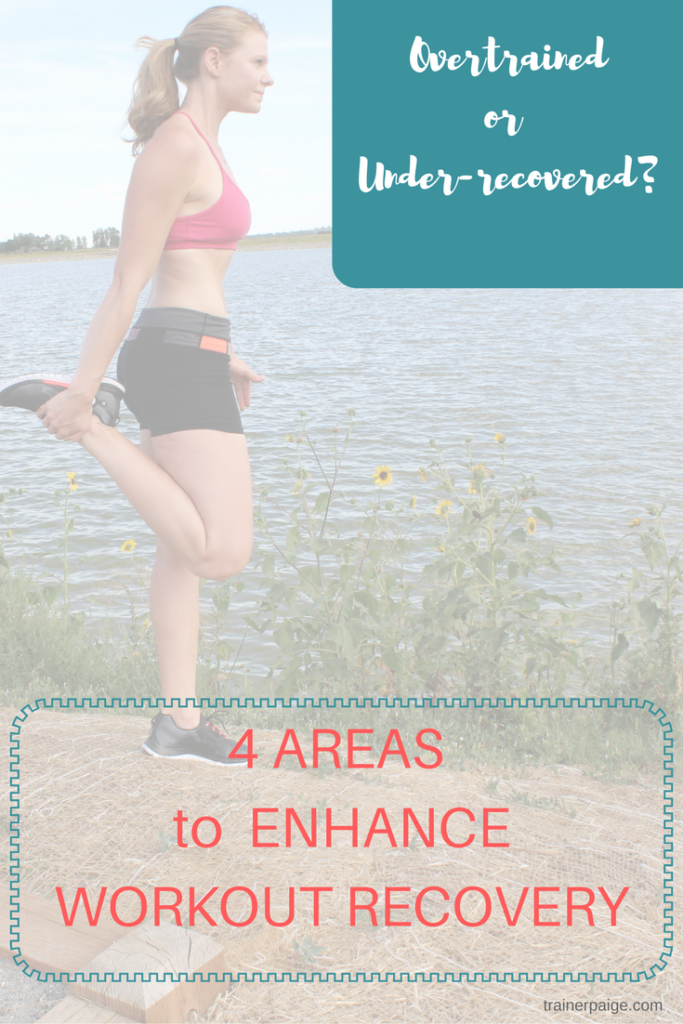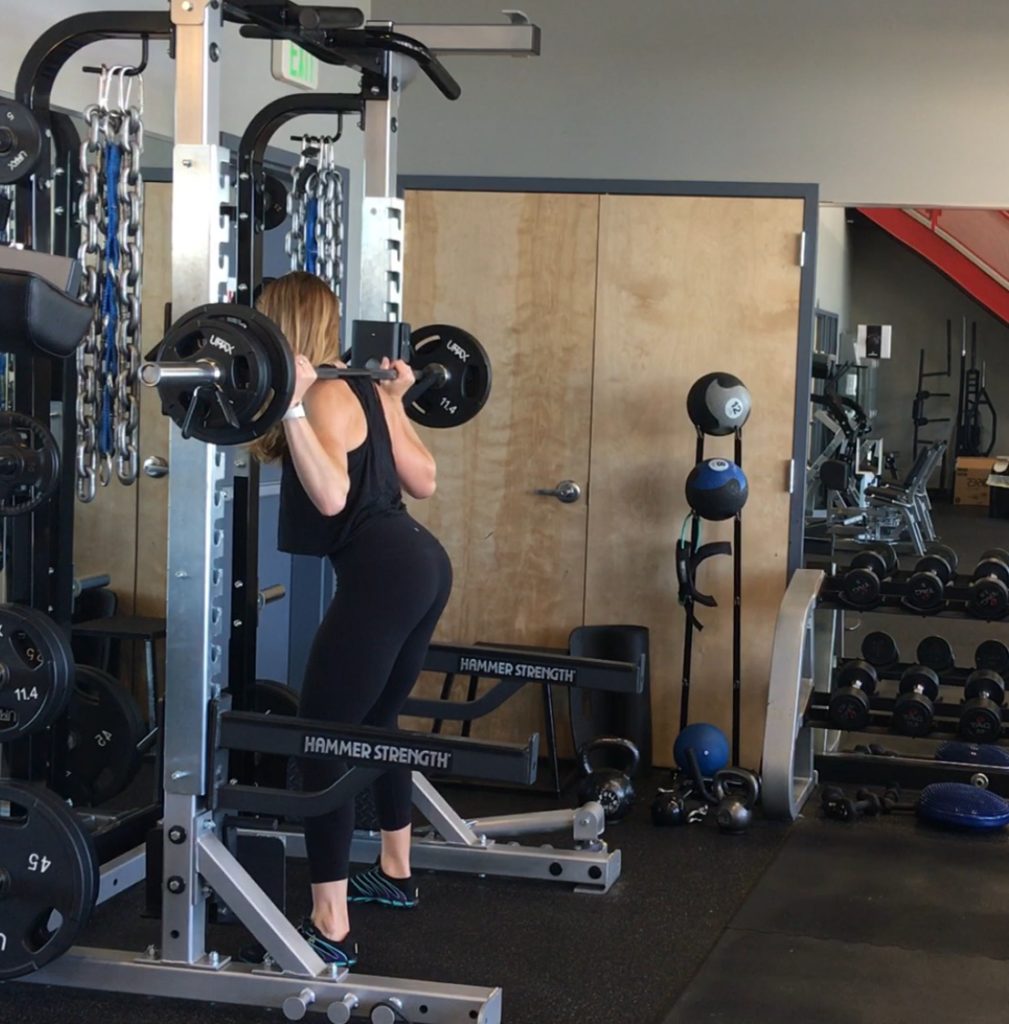Some thoughts and discussions from me.
You hear quite a bit about feeling overtrained in your workouts, and “overtraining syndrome.”
It’s a real thing, and I’ve written about it a time or two myself.
However, in attending Dr. Abbie Smith-Ryan’s workshop on women and nutrition, she casually mentioned that it actually takes quite a bit for us to reach the point of becoming overtrained. The human body can handle quite a large – and frequent – workload before reaching its limit.
What actually happens more often than not is that we’re under recovered.

It’s a no brainer that these two go hand-in-hand, but it’s easy for all of us to just keep pushing– through our workouts and through our life. When the reality is, the harder we train, the more recovery we need (a novel concept, right?)
Are You Overtrained or Under-Recovered?
In the video below, I’m going to talk about:
- the four main areas of recovery, and
- how we can utilize to increase them to stay healthy, especially when our training volume, density, load, frequency, etc. increases.
Summed Up
Quality Sleep
Getting those 7-9 hours of quality sleep is huge when it comes to recovery. Our bodies are SO busy repairing, recovering, and rejuvenating while we’re fast asleep.
At the cellular level, getting good, quality sleep helps with hormone regulation, regulated blood glucose levels, and cognitive process. Interrupted or poor quality sleep can even interfere with protein synthesis. This is a big deal especially if you’re trying to gain or maintain lean body mass while in a deficit. (source)
Proper Periodization
There are three components of this recovery method I want to touch on. The first is the actual periodization of our workout programming. Periodized training is important because it can manage fatigue, vary load and intensity, and essentially allow us to train in a way that allows our bodies to recover better form our workouts. Recovery should be built into our training by providing deload weeks, or phases that change the focus after months and months of focusing on one particular method of training.
In the same vein, how we schedule our weekly workouts can have an effect on recovery as well. For example, if you have a training session that hits the full body pretty hard, you wouldn’t want to follow it up with the same format the following day. You need to account for rest and recovery between sessions. You also wouldn’t likely want to program a heavy, high volume leg day that’s followed by tough hill sprints the next day.

I would aim for 1-2 days of rest between each muscle group, which would allow you to train that muscle group about twice per week. Of course, this is dependent on a multitude of other factors. I will say, however, that studies show women are more resistant to training fatigue than men (just sayin’ 😉 ) (source)
Getting even more granular, the rest in between our sets within each workout should allow for proper recovery between exercises. Of course, again, this is completely dependent on your goals, ability, other stressors, as well as the rep/set/volume scheme of the workout. But the amount of rest between sets, especially with strength-based training, is important. (Mike, Kravitz)
Nutrition
There is a LOT of information that could go under this category. Between macronutrient ranges, carbohydrate cycling – and carb cycling + menstrual cycles (which I recently learned – affects how we utilize carbs vs. fat,) the anabolic window, nutrient deficiencies, supplements, vitamins, etc. there’s quite a bit to cover.

However, I’d suggest to make sure you have a few things in order here:
- Food amount (we need to FUEL for perfomance and recovery)
- Food Quality (i.e. what foods your eating, and their nutrient makeup)
- Macronutrient split
- Nutrient timing
- Supplementation
Figuring out what works for you, and what makes you feel best is key. Basically, there’s WAY too much to talk about here without making each individual point its own blog post 😉
For further reading and funsies, here are a few articles that give some tips that I adhere to:
http://main.poliquingroup.com/articlesmultimedia/articles/article/1262/top_ten_foods_to_reduce_muscle_soreness_speed_reco.aspx
http://www.precisionnutrition.com/about-post-workout-nutrition
Stress Management
When I say to stress in this context, I’m referring to life stressors and psychological stressors. Studies have shown that life stressors and “being stressed out” can indeed inhibit recovery from training in the muscular system. (source) Chronic stress has also been shown to lower testosterone levels (source.)
Listen up: if you’re going through something very big, like a move, the death or illness of a loved one, or just an incredibly stressful time in your life, it’s probably best to decrease your training. If you have chronic or unmanageable stress in your life, additional rest is likely beneficial (source.)
However, we all experience every day stressors in our lives. All of our schedules are jam-packed and we’re ALL running around, dealing with all of our obligations. It’s how we deal with these life stressors that makes an impact.

Here are some ways that I decrease everyday stress in life are the following:
- Taking a morning walk in the sunshine
- Meditation/prayer
- Mantras
- Spending time with loved ones and pets
- Savoring a good book or a glass of wine
- Hiking
to name a few.
This study from the British Journal of Sports Medicine shows that meditation significantly decreased blood lactate concentration after exercise, promoting recovery. Practicing meditation has also been shown to decrease cortisol levels (s), and even facilitate pain-relief (s).
One component I didn’t mention in this post that you might be wondering about is myofascial release and stretching. I do use the foam roller to promote circulation and blood flow, but there are studies that show it does help prevent muscle soreness, and studies that show it doesn’t do much at all. The jury’s still out on this one, but I still foam roll after training, as it helps me cool down, calm down my CNS a bit, and finish out my workout.
How about you? What measures do you take to ensure you’re properly recovered from your workouts?


These are great tips! It took me a really long time to understand that all the points in the nutrient category are important. It isn’t exercising and starving yourself, that isn’t how it works, despite what the multi-billion dollar diet industry wants us to believe. When I started to get injured all the time and stopped recovering well I knew something had to change. All of these things are things I work on staying on top of so I stopped getting injured and start getting the results I want! Great reminders!
YES! So crucial.
LOVE LOVE LOVE this post, Paige!!
Sara @ Oats & Rows recently posted…Birthday Recap + Friday Favorites!
Thank you, Sara!!
At first I read that as Over-Tired or Under-Recovered. I guess that explains how I feel. LOL! I’m am definitely not over-trained. Great tips in here that will help me overcome the over-tired at life too!
Ha! I’m a little overtired this week, too 😉
Great tips and an interesting differentiation! Learning to make more rest or easy days, fuelling properly and getting enough sleep are all key for my recovery. I’ve recently started doing yin yoga which has been great!
Awesome post Paige. I feel like this is such a great topic for us all to become more informed on and take into account when trying to achieve our fitness goals. I just got done with a show prep and was definitely overtraining. I was physically and mentally exhausted and it got to the point where going to the gym was a chore instead of something I looked forward to starting my morning with. You really touched upon periodization in a good way. It’s so crucial. Thanks for the article Paige.
Chris